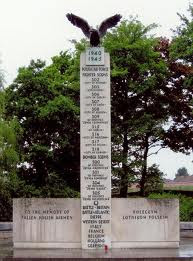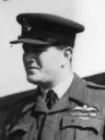Battle of Britain Anniversary ~
London Fly-Past 14th September 1946

Collard, Craig & Beetham
Immediately after returning from well-deserved Leave after the 6-week Goodwill Tour of the USA; the 35 Squadron Personnel urgently re-assembled for further Formation Flying Rehearsals for the imminent 5th Battle Of Britain Anniversary Fly-Past


Saturday 14th September 1946 -the 5th Battle of Britain Anniversary (actual date 15th September 1941) was celebrated by throwing Open to the Public some 60-RAF Stations. Two Mass Fly-pasts of RAF Squadrons were also to have taken place, but recalcitrant Weather caused the 2nd of these to be cancelled. The weather also greatly affected attendance at many Aerodromes whereas at some, Crowds several 1000 strong refused to be deterred by the near-incessant oft-torrential rain, at others only a handful of Spectators turned up to see the Displays.
A Formation of some 300-Aircraft Flew over London in the 1st Battle of Britain Anniversary Flypast. The Formation included 247 Squadron in their new Vampire fighters (as from March 46) flying in from RAF Odiham.
35 Sqdn Lancaster FE Bombers which had just returned from a Goodwill Tour to America led the Fly-past over London.
First Memorial Fly-Past Aircraft (Led by Douglas Bader)
On 14th September 1946, 15 Spitfires of No 1 Squadron flew in the historic 1st Battle of Britain Flypast led by Group Captain Douglas Bader, Flying over London & St Pauls Cathedral.
Hurricanes
Sunderlands
Lancasters – 35 Squadron
Mosquitos
Sea Mosquitos
Beaufighters
Firebrands
Supermarine Seafires
Spitfires – No.1 Squadron
Fireflies
Tempests
Meteors –
Vampires – 247 Squadron


Both these Logbooks note Demonstrations on 28th September 1946 of H2S Navigational Aids on behalf of PICAO International Civil Air Organisations Delegates
300-Fighter Planes Flew over London & South-East Coast Towns in Mass Formation to commemorate the 5th Anniversary of the Battle for Britain. It was the 1st Occasion on which the Battle has been Commemorated by Massed Flights over the whole of the area in which it was Fought during 1940. The Parade consisted of 31-Squadrons of the RAF & Fleet Air Arm, 3-USAAF Squadrons & 7-Polish Squadrons.
The Flight was in 2-Stages. The Track in the morning followed a Straight Line from Southend through Hornchurch & Westminster to Hammersmith. In addition, Towns along the South, South-East & East Coasts were covered. In the afternoon the Aircraft formed up between Selsey & Beachy Head and then flew over Portsmouth, Southampton, the North Coast of the Isle of Wight, Bournemouth, Weymouth, Exeter, Weston-super-Mare, Bath, Bristol, Salisbury & Taunton.

No.1 Squadron then Lying Spitfires was selected to Lead the 1946–Battle of Britain Flypast at the Head of 33 Aircraft, a couple of days later came the News they were Converting to Britain’s 1st Jet Fighter, the Meteor.
The Formation included 247-Squadron in their New Jet Vampire Fighters. Three RAF Hawker Tempest Fighters collided in mid-air after the Fly-past. One crashed, Killing the Pilot the other 2 made Forced Landings.
London, Sat 14th September 1946
The hugely influential 1941 Air Ministry Pamphlet was Founded upon Fact rather than Fiction, its Focus on 15th September 1940 as the ‘Greatest Day’ – or as suggested in 1942, ‘Air Trafalgar Day’ – central to the projection of Fighter Command as the Saviours of the Free World. In other words, had the RAF & Ack Ack Defences not Shot down 185-Aircraft on that day it was proclaimed in the narrative that Hitler would have undoubtedly Launched his Invasion. Not possible to verify until Nazi High Command (OKW) Documents were Captured by the Allies in 1945 – the details finally released in September 1947 – the central claim of the 1941 Pamphlet was then either an inspired insight or calculated misinterpretation.
It is, therefore, difficult to Gauge whether ‘The Battle of Britain’ was a mythical construction simply because if it is accepted that Hitler called off his Invasion Plans given the 15th September Luftwaffe Losses, the Pamphlet’s central argument was a valid claim. Hitler did, in fact, postpone the Invasion on 17th September, this not known clearly until 1947 – as distinct from an opaque Enigma Message, & Barge Dispersals – but it is not known precisely whether this was wholly due to RAF Fighter – and Bomber – resistance, or a combination of factors including the threat posed by the Royal Navy. Alas, different interpretations of Hitler’s Operation Sea Lion and its Abandonment are possible, the Pamphlet’s verdict highly valuable to the British during a Period of continuing Disappointment & Setbacks.
By 1945 the RAF Bomber Attacks against Barge Concentrations in September 1940 had been wholly forgotten, the more delicate issues around the Strategic Air Offensive and the recent Bombing of Dresden tending to Eclipse Bomber Command’s Contribution to the Victory. Bomber Command was not given more just Credit for its Contribution to the Battle of Britain. Garry Campion
Wing Commander Craig (right) in discussion with a fellow Officer and an Organiser regarding the Battle of Britain Anniversary Flight on the 14th September 1946 with reference to the Charity RAF Association possibly prior to an ‘Open Day‘ at Graveley. Craig became a Member of the RAFA Club at 114 Totteridge Road in High Wycombe which Opened New Premises in September 1952.

RAFA, The Royal Air Forces Association (or RAF Association), is a Membership Organisation and Registered Charity that provides Welfare Support to the RAF Family. Friendship , Help & Support
In 1929, in the Sergeants’ Mess at RAF Andover, 3-men named Vernon Goodhand, Joe Pearce & Warrant Officer Bartlett met to discuss the Formation of a single Organisation dedicated to the Welfare of Serving and ex-Serving RAF Personnel: one which would replace the many smaller Organisations that had grown to keep former Servicemen in Touch since the end of WW1. By 1930 a Provisional Committee had been formed called “Comrades of the Royal Air Forces Association” and the 1st General Meeting of the New Organisation took place at the Queen’s Hotel, Leicester Square, London Inset). Air Ministry support for the Comrades came in 1933 when the Air Council officially recognised the Organisation and Lord Trenchard accepted the Presidency. By 1943, with more than 1M Serving in the RAF, the organisation’s name was changed to the Royal Air Forces Association. A National Council, under the Chairmanship of Air Chief Marshal Sir John Steel was Formed to replace the Central Committee of CRAFA. In 1947 Membership reached a Peak with around 200,000-Members and some 565 Branches throughout the UK and in some Overseas Territories.
Receiving no Government Contributions, their Work is completely Funded by the generosity of Members and through Vital Donations from the Supporters to the Wings Appeal. The Association exists in the Recognition that RAF Personnel and their immediate Families dedicate their Lives to their Country, and to ensure that such a Sacrifice does not result in Suffering, poverty or loneliness. Whether it’s an injured Airman Fighting to get back on his feet, a young child missing their Parent away on Overseas Operations, or a WW2 Veteran needing a shoulder to lean on, they are there to help all generations of RAF Service Personnel and their Families.

The Polish Squadrons of the RAF were quite Superior to the less-experienced British Pilots. In fact, the 303-Squadron, also known by the name of “Kosciuszko Squadron” became the most efficient RAF Unit during the Battle of Britain. The Battle of Britain would have been Lost were it not for the Contribution of the Polish Airmen. However, many excellent Polish Pilots Flew in other RAF Squadrons as well. Their Talent & Prestige is evident in the numerous Polish Squadrons created by the RAF in subsequent years – the 304-Bomber, 305-Bomber, 306-Fighter, 307-Night Fighter, 308-Fighter, 309-Reconnaissance, then Fighter; 315-Fighter, 316-Fighter, 317-Fighter, 318 Fighter-Reconnaissance & 663-Air Observation & Artillery Spotting.
The 1,903 Personnel Killed are today Commemorated on the Polish War Memorial at RAF Northolt.





